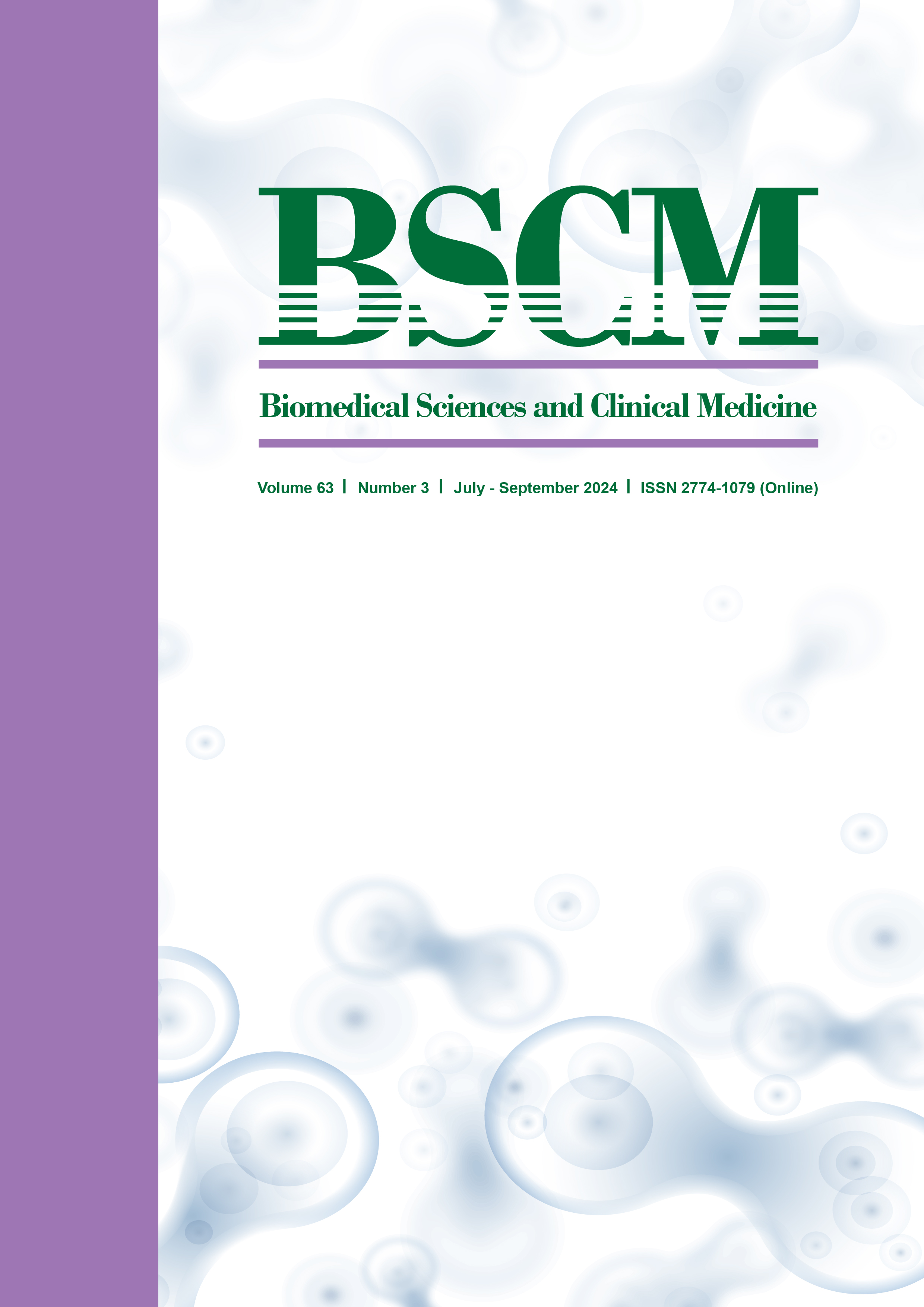Treatment Patterns and Surgical Outcomes of Stage IA1 Cervical Carcinoma
Main Article Content
บทคัดย่อ
Objective The primary objective was to determine the 5-year overall survival rate and 5-year disease-free survival rate of patients with CACx 1A1 treated at Chiang Mai University Hospital and the secondary objective was to describe treatment modalities as well as their associated complications.
Methods Patients with stage IA1 cervical cancer diagnosed from January 2001 to June 2018 at Chiang Mai University Hospital were retrospectively reviewed. Inclusion criteria included previously untreated patients diagnosed with stage IA1 cervical cancer (2018 FIGO staging system). Exclusion criteria were patients with recurrent cervical cancer, other gynecologic malignancies, and those in a pregnant state. The analysis included treatment patterns, surgical types, and clinicopathologic variables, i.e., nodal metastasis, parametrial involvement, positive surgical margins, deep stromal invasion (DSI), lymph-vascular space invasion (LVSI), adjuvant treatment, 5-year disease-free survival, and 5-year overall survival. All pathologic slides were reviewed by gynecologic pathologists. The Kruskal-Wallis test, Fisher’s exact test, the Kaplan-Meier method and log-rank test were used for statistical analysis.
Results Of the 184 patients included in this study, simple hysterectomy was the most common treatment (57.3%), followed by modified radical hysterectomy (MRH) and radical hysterectomy (RH) (27.6% and 9.7% respectively). Conization and radiation were chosen in a few cases. At the median follow up time of 40.8 months, the 5-year disease free survival rate was 99.1% and the 5-year overall survival rate was 95.0%. Pelvic lymph node dissection was done in 62 cases (33.7%), but only one case (0.54%) had pelvic lymph node metastasis.
Conclusions The surgical and survival outcomes for women with stage IA1 cervical cancer are excellent. They can be effectively treated with less radical interventions such as simple hysterectomy and conization. Lymph node metastasis is rare at this stage (0.54%); therefore, lympha-denectomy may possibly be omitted.
Article Details

อนุญาตภายใต้เงื่อนไข Creative Commons Attribution 4.0 International License.
เอกสารอ้างอิง
Sung H, Ferlay J, Siegel RL, Laversanne M, Soerjomataram I, Jemal A, et al. Global Cancer Statistics 2020: GLOBOCAN Estimates of Incidence and Mortality Worldwide for 36 Cancers in 185 Countries. CA Cancer J Clin. 2021;71:209-49.
Bhatla N, Berek J, Cuello Fredes M, Denny L, Grenman S, Karunaratne K, et al. Revised FIGO staging for carcinoma of the cervix uteri. Int J Gynecol Obstet. 2019; 145:129-35.
Quinn M, Benedet J, Odicino F, Maisonneuve P, Beller U, Creasman W, et al. Carcinoma of the cervix uteri. FIGO 26th Annual Report on the Results of Treatment in Gynecological Cancer. Int J Gynaecol Obstet. 2006;95(Supplement_1):S43-103.
Roman L, Felix J, Muderspach L, Agahjanian A, Qian D, Morrow CP. Risk of residual invasive disease in women with microinvasive squamous cancer in a conization specimen. Obstet Gynecol. 1997;90:759-64.
Benedet J, Anderson G. Stage IA carcinoma of the cervix revisited. Obstet Gynecol. 1996;87:1052-9.
Abu-Rustum N, Yashar C, Arend R, Barber E, Bradley K, Brooks R, et al. NCCN Guidelines® Insights: Cervical Cancer, Version 1.2024. J Natl Compr Canc Netw. 2023;21:1224-33.
Bhatla N, Aoki D, Sharma D, Sankaranarayanan R. Cancer of the cervix uteri: 2021 update. Int J Gynecol Obstet. 2021;155:28-44.
Lee S, Kim Y, Son W, You H, Kim D, Kim J, et al. The efficacy of conservative management after conization in patients with stage IA1 microinvasive cervical carcinoma. Acta Obstet Gynecol Scand. 2009;88:209-15.
Wright J, NathavithArana R, Lewin S, Sun X, Deutsch I, Burke W, et al. Fertility-conserving surgery for young women with stage IA1 cervical cancer: safety and access. Obstet Gynecol. 2010;115:585-90.
Spoozak L, Lewin S, Burke W, Deutsch I, Sun X, Herzog T, et al. Microinvasive adenocarcinoma of the cervix. Am J Obstet Gynecol. 2012;206:80.e1-6. PubMed PMID: 21939955
Bean LM, Ward KK, Plaxe SC, McHale MT. Survival of women with microinvasive adenocarcinoma of the cervix is not improved by radical surgery. Am J Obstet Gynecol. 2017;217:332.e1-332.e6. PubMed PMID: 28522318
Haller H, Krasevic M, Mamula O, Brncic-Fischer A, Eminovic S, Manestar M. Treatment and outcome of stage Ia1 squamous cell carcinoma of the uterine cervix. Int J Gynaecol Obstet. 2011;113:72-5.
Yahata H, Sonoda K, Yasunaga M, Ohgami T, Kawano Y, Kaneki E, et al. Surgical treatment and outcome of early invasive adenocarcinoma of the uterine cervix (FIGO stage IA1). Asia Pac J Clin Oncol 2018;14:e50-e3. PubMed PMID: 28429457
Baalbergen A, Smedts F, Helmerhorst T. Conservative therapy in microinvasive adenocarcinoma of the uterine cervix is justified: an analysis of 59 cases and a review of the literature. Int J Gynecol Cancer. 2011; 21:1640-5.


